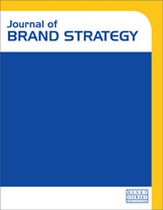Brand equity trend analysis for top auto brands on Interbrand’s 20-year longitudinal data
Abstract
This study aims to explore the brand equity trends among the top 100 global automobile brands during the last two decades. Using 20 years of longitudinal data published by Interbrand on brand equity ranking of 100 Best Global Brands (2001–2020), a trend analysis was performed on 18 global automobile brands that appeared on this list. The trend analysis was conducted based on the aggregated annual brand equity of all brands, the number of brands by region and country, growth patterns in brand equity and per-unit brand equity (UBE) for six countries and three regions. Major trends presented in the article include the relegation of American brands, the resilience of Asian brands, the dominance of European brands, the deleterious impact of the global financial crisis of 2008 and the COVID-19 pandemic on the automobile industry, four clusters within the best automobile brands and per UBE. The clusters include leaders, challengers, starlets and intermittent. The ‘Leader’ cluster includes top brands like Toyota, Mercedes-Benz, BMW, Honda, Ford and Volkswagen and appeared 20 times in 20 years on Interbrand’s global brand list with minimum brand equity of US$12bn in 2020. The ‘Challengers’ cluster includes brands like Hyundai, Audi, Porsche and Nissan, which have a higher brand equity growth rate than other clusters. The ‘Starlet’ cluster includes Ferrari, Land Rover, Kia and Mini Cooper, all of which are operating in niche markets, except for Kia. The fourth cluster, named ‘Intermittent’, includes auto brands like Chevrolet, Subaru, Lexus and Tesla. The analysis of per UBE presented in this article for the first time has shown a novel way of looking at automobile brand equity. It explains why Ferrari and Porsche have exceptionally high per UBE, which is reflected by high prices and a low number of units produced. The managerial and academic implications of the research and limitations are presented in the end.
The full article is available to subscribers to the journal.
Author's Biography
Kamran Ahmed Siddiqui Dr Kamran Ahmed Siddiqui works at Imam Abdulrahman Bin Faisal University as an Associate Professor of Marketing & Entrepreneurship. He received his PhD (Business Administration) from Manchester Business School, U.K., and a Masters in Marketing from the University of Bradford, UK. He also holds an MBA-MIS from IBA, Karachi, Pakistan. With over 30 years of experience in the corporate and education sectors, he has extensively written on brand equity trend analyses for global financial institutions during financial and pandemic crises, for fastest-growing countries of origin and for top luxury brands. He was also an instrumental author for factor analytics and content analytic findings on brand failure, intergenerational brand influences and Islamic branding.
Shabir Ahmad Dr Shabir Ahmad is a faculty member at the College of Business Administration, Imam Abdulrahman Bin Faisal University, Saudi Arabia. He earned a PhD in Management with distinction from UTM, Malaysia, and an MBA in International Business from Cardiff Metropolitan University, U.K. His research focuses on corporate sustainability, family businesses, innovation, entrepreneurship and CSR. His work has been published in various reputed journals, including Journal of Family Business Management, Journal of Small Business and Enterprise Development, Journal of Entrepreneurship in Emerging Economies and Sage Open Journal. In addition, he serves as article editor for Sage Open Journal and as a reviewer for Business and Society Review, Journal of Law and Management and Journal of Asian Business & Management.
